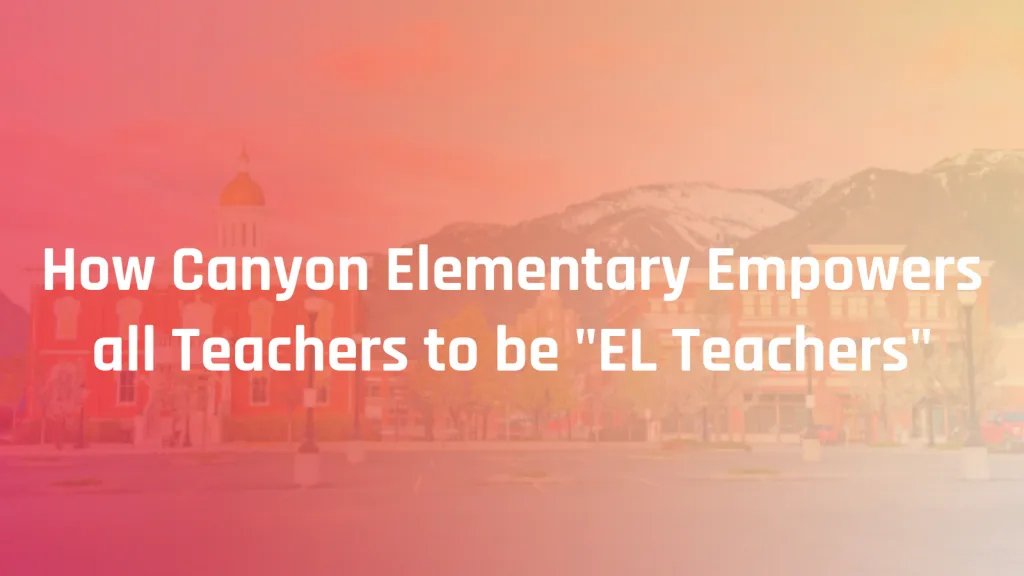Empowering All Teachers to be “EL Teachers”


Empowering All Teachers to be “EL Teachers”
Hear from educators and administrators at a school in Cache County, UT that successfully rolled out Ellevation Strategies to address gaps in testing and increase engagement from language learners.
Cache County school district in northern Utah serves close to 20,000 K-12 students; about 1,000 of those students are considered Limited English Proficient. Cache County is one of the overall highest performing districts in the state of Utah. Yet several years ago they were placed on targeted school improvement (TSI) by the state due to insufficient growth by their ELs on standardized testing.
The school leaders realized that their educators needed additional tools and training to be able to offer the same high quality of education to their ELs as the rest of their students - without overwhelming teachers.
Canyon Elementary has the highest population of EL students amongst the elementary schools, with English learners accounting for 10% of their school population. We visited their campus to learn more about their response to TSI and how they transformed their approach to serving ELs.
Challenges for supporting academic growth in ELs
Even before the state placed their district on the TSI list, teachers and administrators knew there was a disconnect with their EL instruction. Teachers often noticed that their multilingual students were not participating enough in class, and testing showed that achievement gaps grew for ELs during COVID. However, they were unsure how to restructure their approach.
“We didn't know where to start because our data was in so many different places. It was a struggle to be able to know where our holes even were. All we were told was our EL students aren't making enough growth, but we weren't sure which skills to exactly target,” says Melinda LaMont, an EL Specialist for Cache County.
Beyond tackling student data, LaMont explains that teachers at Canyon needed new strategies and training to support their ELs.
“It was really hard to figure out times to meet with our teachers and offer up the kind of PD they need. Of course, we'd like them all to get their EL endorsements, but those are expensive and time consuming. We had trouble finding the right way to help our teachers improve their capacity and also get them the data that they need.”
Impact of Ellevation Strategies on teachers and instruction
When Canyon teachers got access to the Ellevation Platform, they were quickly able to identify where the learning gaps were for their ELs and had a centralized place to track their EL’s data. But they still needed to bridge the gap between seeing the data and figuring out how to address those needs in their classroom.
“It was really helpful when we rolled out Ellevation Strategies to say, ‘Now you know what your students' needs are. Here's a tool for you to help them in your classroom with your instruction and make the content more accessible for those students," LaMont explains. “The Ellevation modules gave us that little bit of specific PD alongside their own student data so they immediately see how their learning applies to their individual student needs.”
Beyond the personalization of the lessons, administrators at Canyon Elementary were also pleased to find that the flexible format of the professional learning was positively received by their classroom teachers.
“Across the country, teachers are getting PD that feels like ‘one more thing’. These modules don't feel that way,” Stacie Williamson, the principal at Canyon Elementary shares “You can see the teachers’ minds start immediately going, ‘I can see how I can use this.’”
In addition to being a format that is actionable without being overwhelming, the team at Canyon observed another change in their teachers.
“When we started using the modules, you could see them grow in their confidence to talk about what they were doing in the classroom with each other. We just gained those skills month after month - you can see that efficacy build, that ‘I can do this. I can be a good EL teacher,’” Principal Williamson shares.
“It's helping us all see that these students are something that adds to our classroom. They're not just something that we put in the corner and hope that that aide, or whoever's going to work with them, takes care of them while we work with the rest of the class. They're embedded in the whole class,” says Heather Eames, a fourth grade teacher.
Outcomes for Canyon’s ELs
As teachers began implementing these new strategies into their classrooms, the change in their ELs was palpable.
“I've seen that the students are more aware of their own individual knowledge. Their confidence in themselves in participating and their understanding has really increased throughout the use of these modules and strategies,” shares Tiffany Farnsworth, an English Language Learner Teacher at Canyon.
Since adopting Ellevation, the percent of EL students in the district meeting the state expectation for growth increased by nearly 18%. At Canyon Elementary, this number increased by 25%. Additionally, Canyon exited 18% of their EL students, an 8% increase from 2021 to 2022. The district increased from 6.6% to 11.5% exited students, nearly doubling the state's average.
Canyon Elementary is a prime example of a change happening in schools across the country: student populations are becoming increasingly linguistically and culturally diverse, and many educators are seeing multilingual learners on their class roster for the first time. With support from their administration and a school culture that prioritizes collaboration and on-going professional learning opportunities, educators can feel confident in their ability to support these students.
“Before, teachers were saying, ‘I don't really know how to service ELs in my class. I don't have an ESL endorsement. I'm not sure how to help them,’’’ Farnsworth shares. “Now they’re asking, ‘Hey, can I have an EL student next year? I want those multilingual learners with me.”